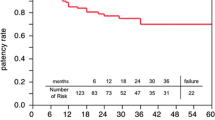Abstract
Background: Coronary artery remodeling is a common phenomenon in human atherosclerotic arteries. Controversies exist concerning the presence of absence of the remodeling process in diseased human coronary saphenous vein bypass grafts. The purpose of the study was to observe the vessel and lumen dimensions in patients who had undergone saphenous vein grafting with intravascular ultrasound to find out whether the remodeling process exists in the diseased human saphenous vein bypass grafts. Methods: A total of 43 saphenous vein bypass grafts from 43 patients (39 males, 4 females, mean age 63 ± 8 years); 1–16 years (mean 9.3 ± 4.0 years) after grafting, who had not undergone previous catheter intervention, were studied using intravascular ultrasound. The vessel, lumen and plaque area were measured at the lesion segment as well as in the proximal and distal reference segments. The percent stenosis was calculated. Results: In 43 bypass grafts having severe stenosis before intervention, plaque was eccentric in 69.4% and concentric in 30.6%. No calcification was detected in 75% cases and 25% cases has mild-moderate intimal calcification. The vessel area in the lesion segment was 19.0 ± 9.7 mm2, significantly larger than the proximal reference segment 12.8 ± 4.0 mm2 as well as the distal reference segment 12.9 ± 3.6 mm2 (p < 0.001). It was also larger than that of the average area of the proximal and distal reference segments (p < 0.001). The vessel area increased in accordance with plaque area (p < 0.001). A weak relationship existed between vessel area and percent stenosis (r = 0.37, p = 0.04). Conclusion: In contrary to previous findings, diseased human saphenous vein bypass grafts undergo focal compensatory enlargement (remodeling) in the presence of plaque formation. The underlying mechanism is probably similar to that in de novo atherosclerosis.
Similar content being viewed by others
References
Glagov S, Weisenberg E, Zarins CK, Stankunavicius R, Kolettis GJ. Compenstory enlargement of human coronary arteries. N Eng J Med 1987; 316: 1371-1375.
McPherson DD, Sirna SJ, Hiratzka LF, Thorpe L, Armstrong ML, Marcus ML, Kerber RE. Coronary arterial remodeling studied by high-frequency epicardial echocardiography: an early compensatory mechanism in patients with obstructive coronary atherosclerosis. J Am Coll Cardiol 1991; 17: 79-86.
Ge J, Erbel R, Zamorano J, Koch L, Kearney P, Görge G, Gerber T, Meyer J. Coronary arterial remodeling in atherosclerotic disease: an intravascular ultrasound study in vivo. Coron Arery Dis 1993; 4: 981-986.
Pasterkamp G, Wensing PJW, Post MJ, Hillen B, Mali WPTM, Borst C. Parodoxical arterial wall shrinkage may contribute to lumen narrowing of human atherosclerotic femoral arteries. Circulation 1995; 91: 1444-1449.
Campeau L, Enjalbert M, Lesperance J et al. The relation of risk factors to the development of atherosclerosis in saphenous-vein bypass grafts and the progression of disease in the native circulation. N Eng J Med 1984; 311: 1329-1332.
White C, Campeau L, Knatterud G, Probstfield J, Investigators at PCCT. Patency of saphenous vein bypass grafts following elective angiography: Preliminary results from the POST CABG Clinical Trial. J Am Coll Cadiol 1993; 21: 18A.
Ge J, Liu F, Görge G, Haude M, Baumgart D, Erbel R. Angiographically ‘silent’ plaque in the left main coronary artery detected by intravascular ultrasound. Coron Artery Dis 1995; 6: 805-810.
Nishioka T, Luo H, Berglund H, Eigler N, Kim C-J, Tabak S, Siegal R. Absence of focal compensatory enlargement or constriction in diseased human coronary saphenous vein bypass grafts. An Intravascular Ultrasound Study. Circulation 1996; 93: 683-690.
Baumgart D, Haude M, Ge J, Görge G, Liu F, Shah V, Erbel R. Online intergration of intravascular ultrasound ultrasound images into angiographic images. Cathet cardiovasc Diagn 1996; 39: 328-329.
Siegal RJ, Swan K, Edwalds G, Fishbein MC. Limitations of postmortem assessment of human coronary artery size and luminal narrowing: differential effects of tissue fixation and processing on vessels with different degrees of atherosclerosis. J Am Coll Cardiol 1985; 5: 342-346.
Zarins CK, Weisenberg E, Kolettis G, Stankunavicius R, Glagow S. Differential enlargement of artery segments in response to enlarging atherosclerotic plaques. J Vasc Surg 1988; 7: 386-394.
Angelini GD, Newby AC. The future of saphenous vein as coronary artery conduit. Eur Heart J 1989; 10: 273-280.
Author information
Authors and Affiliations
Rights and permissions
About this article
Cite this article
Ge, J., Liu, F., Bhate, R. et al. Does remodeling occur in the diseased human saphenous vein bypass grafts? An intravascular ultrasound study. Int J Cardiovasc Imaging 15, 295–300 (1999). https://doi.org/10.1023/A:1006125205217
Issue Date:
DOI: https://doi.org/10.1023/A:1006125205217




